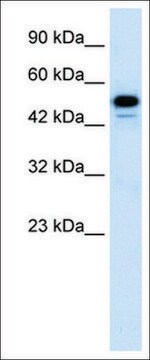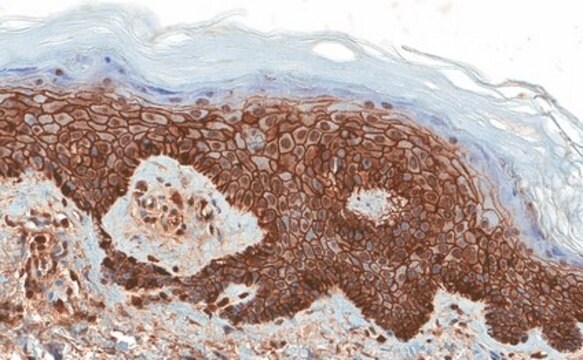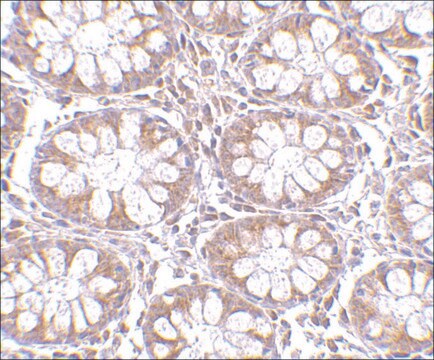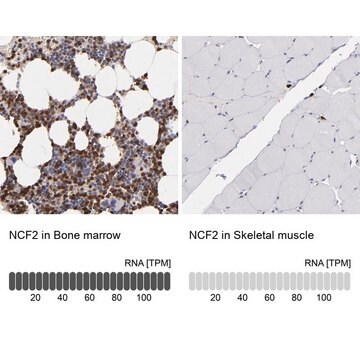推荐产品
生物源
rabbit
品質等級
共軛
unconjugated
抗體表格
affinity isolated antibody
抗體產品種類
primary antibodies
無性繁殖
polyclonal
產品線
Prestige Antibodies® Powered by Atlas Antibodies
形狀
buffered aqueous glycerol solution
物種活性
human
技術
immunohistochemistry: 1:50- 1:200
免疫原序列
FYTVETVSSGTDCRCSCTAPPSSLNPCENEWKMEKLKKQAPELLKLQSMVDLLEGTLYSMDLMKVHAYVHKVASQMNTLEESIKANLSREN
UniProt登錄號
運輸包裝
wet ice
儲存溫度
−20°C
目標翻譯後修改
unmodified
基因資訊
human ... OLFML2A(169611)
一般說明
The gene OLFML2A (olfactomedin-like protein 2A) is mapped to human chromosome 9q33.3. It is expressed in glomerular podocytes. It belongs to the olfactomedin family.
免疫原
Olfactomedin-like protein 2A Precursor recombinant protein epitope signature tag (PrEST)
應用
All Prestige Antibodies Powered by Atlas Antibodies are developed and validated by the Human Protein Atlas (HPA) project and as a result, are supported by the most extensive characterization in the industry.
The Human Protein Atlas project can be subdivided into three efforts: Human Tissue Atlas, Cancer Atlas, and Human Cell Atlas. The antibodies that have been generated in support of the Tissue and Cancer Atlas projects have been tested by immunohistochemistry against hundreds of normal and disease tissues and through the recent efforts of the Human Cell Atlas project, many have been characterized by immunofluorescence to map the human proteome not only at the tissue level but now at the subcellular level. These images and the collection of this vast data set can be viewed on the Human Protein Atlas (HPA) site by clicking on the Image Gallery link. We also provide Prestige Antibodies® protocols and other useful information.
The Human Protein Atlas project can be subdivided into three efforts: Human Tissue Atlas, Cancer Atlas, and Human Cell Atlas. The antibodies that have been generated in support of the Tissue and Cancer Atlas projects have been tested by immunohistochemistry against hundreds of normal and disease tissues and through the recent efforts of the Human Cell Atlas project, many have been characterized by immunofluorescence to map the human proteome not only at the tissue level but now at the subcellular level. These images and the collection of this vast data set can be viewed on the Human Protein Atlas (HPA) site by clicking on the Image Gallery link. We also provide Prestige Antibodies® protocols and other useful information.
生化/生理作用
OLFML2A (olfactomedin-like protein 2A) is suggested to be involved in podocytes-mediated processes.
特點和優勢
Prestige Antibodies® are highly characterized and extensively validated antibodies with the added benefit of all available characterization data for each target being accessible via the Human Protein Atlas portal linked just below the product name at the top of this page. The uniqueness and low cross-reactivity of the Prestige Antibodies® to other proteins are due to a thorough selection of antigen regions, affinity purification, and stringent selection. Prestige antigen controls are available for every corresponding Prestige Antibody and can be found in the linkage section.
Every Prestige Antibody is tested in the following ways:
Every Prestige Antibody is tested in the following ways:
- IHC tissue array of 44 normal human tissues and 20 of the most common cancer type tissues.
- Protein array of 364 human recombinant protein fragments.
聯結
Corresponding Antigen APREST75400
外觀
Solution in phosphate-buffered saline, pH 7.2, containing 40% glycerol and 0.02% sodium azide
法律資訊
Prestige Antibodies is a registered trademark of Merck KGaA, Darmstadt, Germany
未找到合适的产品?
试试我们的产品选型工具.
儲存類別代碼
10 - Combustible liquids
水污染物質分類(WGK)
WGK 1
閃點(°F)
Not applicable
閃點(°C)
Not applicable
Catherine Guette et al.
Proteomics. Clinical applications, 9(1-2), 58-63 (2014-11-18)
Olfactomedin-4 (OLFM4, OLM4) is a 72 kDa secreted glycoprotein belonging to the olfactomedin family. The OLFM4 gene expression is regulated by the transcription factors NF-kappa B and AP-1, and the OLM4 functions are poorly understood. OLM4 has been described as
Laleh Sistani et al.
Kidney international, 83(1), 63-71 (2012-08-24)
The podocyte has a central role in the glomerular filtration barrier typified by a sophisticated morphology of highly organized primary (major) and secondary (foot) processes. The molecular makeup of foot processes is well characterized, but that of major processes is
Suely K N Marie et al.
International journal of cancer, 122(4), 807-815 (2007-10-26)
We have performed cDNA microarray analyses to identify gene expression differences between highly invasive glioblastoma multiforme (GBM) and typically benign pilocytic astrocytomas (PA). Despite the significant clinical and pathological differences between the 2 tumor types, only 63 genes were found
我们的科学家团队拥有各种研究领域经验,包括生命科学、材料科学、化学合成、色谱、分析及许多其他领域.
联系技术服务部门








